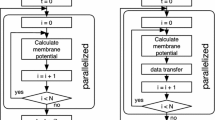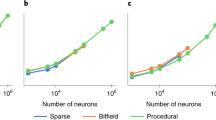Abstract
To understand the processing mechanism of sensory information in the brain, it is necessary to simulate a huge size of network that is represented by a complicated neuron model imitating actual neurons. However, such a simulation requires a very long computation time, failing to perform computer simulation with a realistic time scale. In order to solve the problem of computation time, we focus on the reduction of computation time by GPGPU, providing an efficient method for simulation of huge number of neurons. In this paper, we develop a computational architecture of GPGPU, by which computation of neurons is performed in parallel. Using this architecture, we show that the GPGPU method significantly reduces the computation time of neural network simulation. We also show that the simulations with single and double float precision give little significant difference in the results, independently of the neuron models used. These results suggest that the GPGPU computation with single float precision could be a most efficient method for simulation of a huge size of neural network.
Similar content being viewed by others
References
Mass, W., Bishop, C.M.: Pulsed Neural Networks. MIT Press, Cambridge (1999)
Brette, R., et al.: Simulation of networks of spiking neurons: a review of tools and strategies. J. Comput. Neurosci. 23(3), 349–398 (2007)
Fidjeland, A.K., Shanahan, M.P.: Accelerated simulation of spiking neural networks using GPUs. In: Proceedings of WCCI 2010 IEEE World Congress on Computational Intelligence, pp. 536–543. Barcelona, Spain (2010)
Nageswaran, J.M., et al.: A configurable simulation environment for the efficient simulation of large-scale spiking neural networks on graphical processors. Neural Netw. 22(5–6), 791–800 (2009)
Pallipuram, V.K., Bhuiyan, M., Smith, M.C.: A comparative study of GPU programing models and architectures using neural networks. J. Supercomput. 61, 673–718 (2012)
Tuckwell, H.C.: Introduction to Theoretical Neurobiology. Cambridge University Press, Cambridge (1988)
Izhikevich, E.M.: Simple model of spiking neurons. IEEE Trans. Neural Netw. 14(6), 1569–1572 (2003)
Doiron, B., et al.: Ghostbursting: a novel neuronal burst mechanism. J. Comput. Neurosci. 12, 5–25 (2002)
Hodgking, A.L., Huxley, A.F.: A quantitative description of membrane current and its application to conduction and excitation in nerve. J. Physiol. 117(4), 500–544 (1952)
Acknowledgement
This article was supported by Grant-in-aid for Scientific Research from the Japan Society for the promotion of Science (Number 15K07146).
Author information
Authors and Affiliations
Corresponding author
Editor information
Editors and Affiliations
Rights and permissions
Copyright information
© 2017 Springer International Publishing AG
About this paper
Cite this paper
Okuno, S., Fujita, K., Kashimori, Y. (2017). Computational Efficacy of GPGPU-Accelerated Simulation for Various Neuron Models. In: Liu, D., Xie, S., Li, Y., Zhao, D., El-Alfy, ES. (eds) Neural Information Processing. ICONIP 2017. Lecture Notes in Computer Science(), vol 10638. Springer, Cham. https://doi.org/10.1007/978-3-319-70139-4_81
Download citation
DOI: https://doi.org/10.1007/978-3-319-70139-4_81
Published:
Publisher Name: Springer, Cham
Print ISBN: 978-3-319-70138-7
Online ISBN: 978-3-319-70139-4
eBook Packages: Computer ScienceComputer Science (R0)




